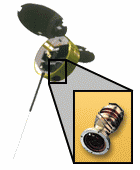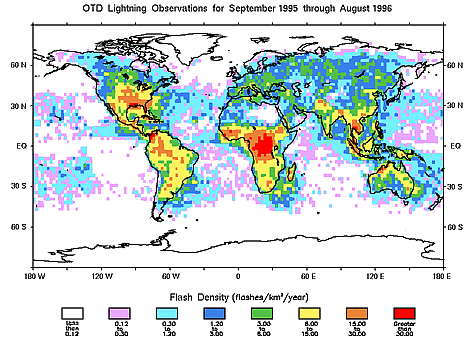 The Optical Transient Detector (OTD) is a highly compact combination of optical and electronic elements. It was developed as an in-house project at NASA's Marshall Space Flight Center in Huntsville, Alabama. The name, Optical Transient Detector, refers to its capability to detect the momentary changes in an optical scene which indicate the occurrence of lightning. The OTD instrument is a major advance over previous technology in that it can gather lightning data under daytime conditions as well as at night. In addition, it provides much higher detection efficiency and spatial resolution than has been attained by earlier lightning sensors.
The Optical Transient Detector (OTD) is a highly compact combination of optical and electronic elements. It was developed as an in-house project at NASA's Marshall Space Flight Center in Huntsville, Alabama. The name, Optical Transient Detector, refers to its capability to detect the momentary changes in an optical scene which indicate the occurrence of lightning. The OTD instrument is a major advance over previous technology in that it can gather lightning data under daytime conditions as well as at night. In addition, it provides much higher detection efficiency and spatial resolution than has been attained by earlier lightning sensors.
 At the heart of the system is a solid-state optical sensor similar in some ways to a TV camera. However, in overall design and many specific features, OTD had to be uniquely designed for the job of observing and measuring lightning from space. Like a TV camera, the OTD has a lens system, a detector array (serving a function somewhat analogous to the retina in the human eye), and circuitry to convert the electronic output of the system's detector array into useful data.
At the heart of the system is a solid-state optical sensor similar in some ways to a TV camera. However, in overall design and many specific features, OTD had to be uniquely designed for the job of observing and measuring lightning from space. Like a TV camera, the OTD has a lens system, a detector array (serving a function somewhat analogous to the retina in the human eye), and circuitry to convert the electronic output of the system's detector array into useful data.
The sensor system (camera) is approximately 8 inches in diameter and 15 inches high, while the supporting electronics package is about the size of a standard typewriter. Together, the two modules weigh approximately 18 kilograms (40 pounds). The total weight of the satellite placed on orbit is 75 kilograms (165 pounds). Operations Under an agreement between NASA and the Orbital Sciences Corporation, the Optical Transient Detector was carried as a secondary payload on a Pegasus, an Orbital Sciences Corporation air-launched rocket. The Pegasus launch on April 3, 1995, delivered the OTD into an Earth orbit of approximately 710 kilometers (446 miles) altitude, with an inclination of 70 degrees. With that orbit, and OTD's wide 100-degree field of view, it surveys virtually all areas of the globe where lightning normally occurs. The combination of the wide field-of-view lens and the altitude of the orbit allows OTD to observe an area of the earth equivalent to 1300x1300 sq km (about 1/300 of the total surface area of the earth) as it orbits the globe.
OTD was expected to be in operation for only two years, but has continued recording the occurrence and worldwide distribution of lightning beyond the expected mission lifetime. The data are transmitted on a daily basis from OTD to a ground station in Fairmont, West Virginia. From there, the data are sent to the Global Hydrology and Climate Center in Huntsville, Alabama, for processing, analysis, and distribution to the scientific community.
The OTD data and associated scientific research has confirmed its importance in contributing to the understanding of atmospheric and precipitation processes. This contribution has reinforced the need for similar observations from geosynchronous orbit, where storm morphology can be monitored continuously.
In recent years, scientists have become increasingly aware of the key role played by lightning in the dynamic interplay of forces occurring in the Earth's atmosphere. Research has indicated that lightning may be a very good indicator of the strength of convective storm systems. The OTD has contributed to the discovery of potential lightning indicators for application to more timely hazardous weather and tornado warnings, and for improved forest fire and wild-land fire management; to the use of lightning as a proxy for detecting intense atmospheric convection; to the production of the most complete and detailed maps of the global lightning distribution; and to the discovery that the global flash rate is approximately 40 flashes per second, less than half of the widely accepted estimates dating back to 1925. One of Many Results Between September 1, 1995 and August 31, 1996, the OTD observed nearly 1 million lightning flashes worldwide. The lightning flash densities (flashes per square kilometer per year) shown on the image have been calculated statistically using OTD data from more than 400 separate 3 minute observations of each location on the earth. From this information, it is now estimated that over 1.2 billion lightning flashes (intracloud plus cloud-to-ground) occur around the world every year. Most of the lightning is in the InterTropical Convergence Zone (ITCZ) over the continents, and there is far more lightning over the land masses than over the oceans. This results from the stronger vertical motions in continental clouds than in oceanic clouds. 
Data Information OTD was launched on April 3, 1995 aboard the MicroLab-1 satellite into a near polar orbit at an inclination of 70 degrees with respect to the equator. The satellite orbits the Earth once every 100 minutes at an altitude of 740km, and at any given instant views a 1300km x 1300km region of the Earth at 128 x 128 pixels. The instrument has a spatial resolution of 10km and a temporal resolution of 2ms.
"Flashes" are determined by comparing the luminance of adjoining frames of OTD optical data. If the difference is more than a specified threshold value, an "event" is recorded. One or more adjacent events in the same 2ms time frame is recorded as a "group". One or more groups within a sufficiently small time period are classified as a "flash". These are grouped into "areas" if there are one or more sufficiently separated from existing areas.
The OTD detects lightning flashes during both daytime and nighttime conditions with a detection efficiency ranging from 40% to 65%, depending upon external conditions such as glint and radiation. The LIS instrument, for which OTD is the engineering prototype, will have a detection efficiency of approximately 90%. The reason for the discrepancy is that the OTD was built under rush conditions and was the best that could be constructed in the mere nine months the team spent on design, fabrication, space qualification, calibration, and delivery.
Because the OTD never observes a given location for more than a few minutes each day its data may be unsuitable for studying localized weather. What it is suitable for is studying global lightning patterns and how they change with time. It can also prove a valuable comparison item if the OTD happens to be in the right spot at the right time to gather data on a given storm. In these cases, the data can be compared against data from other sources to get an estimate of the total flash rate of the storm.
OTD Browse Data is available to provide a quick, graphical overview of the OTD data. Each day of OTD data has been totaled into a single image. Using these images, it is easy to tell from a glance on which days there was a particularly high or low amount of lightning activity over a given area. At the end of each month, OTD Browse Data is quality checked and archived.
A QuickTime movie of example OTD data is also available. This movie consists of a series of browse images played as a sequence to give a feel of the lightning dispersion over the Earth.
References:
Related Links:
Have you used our data? Register for updates